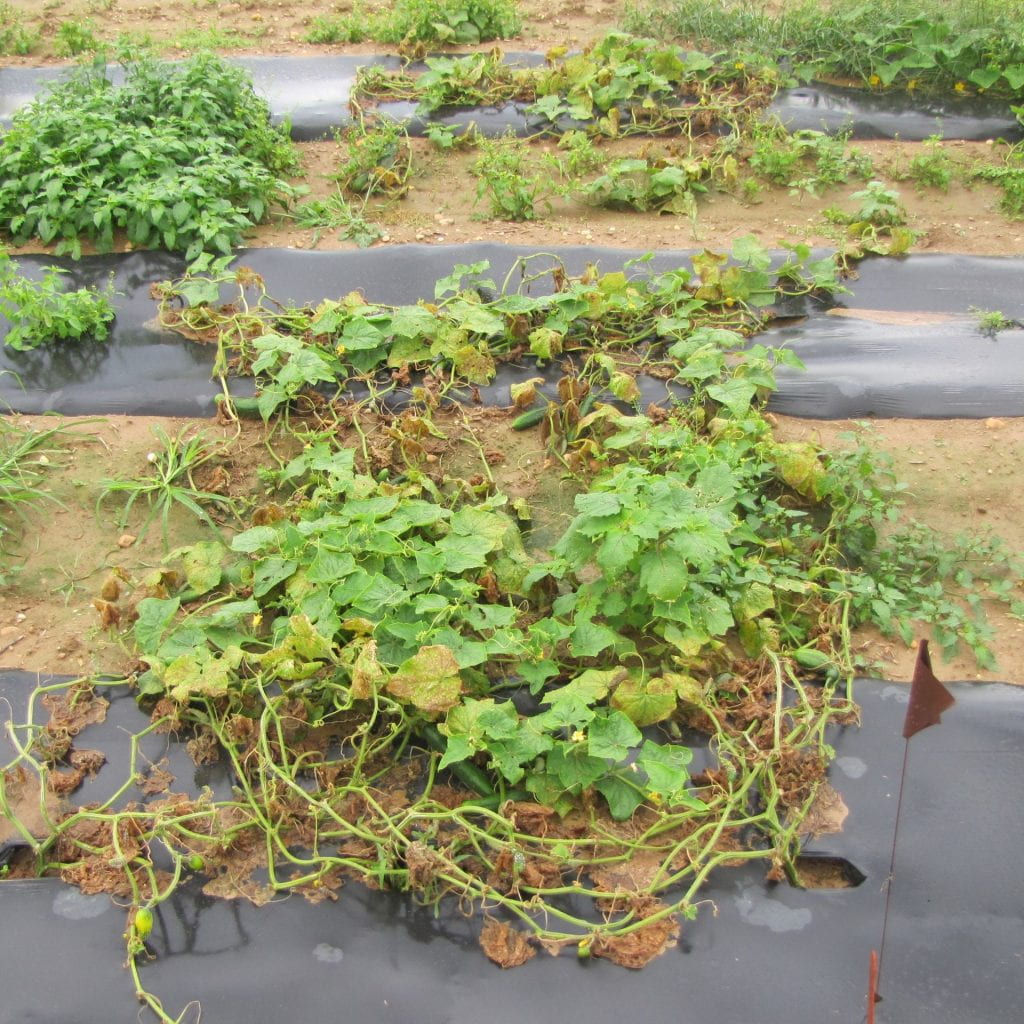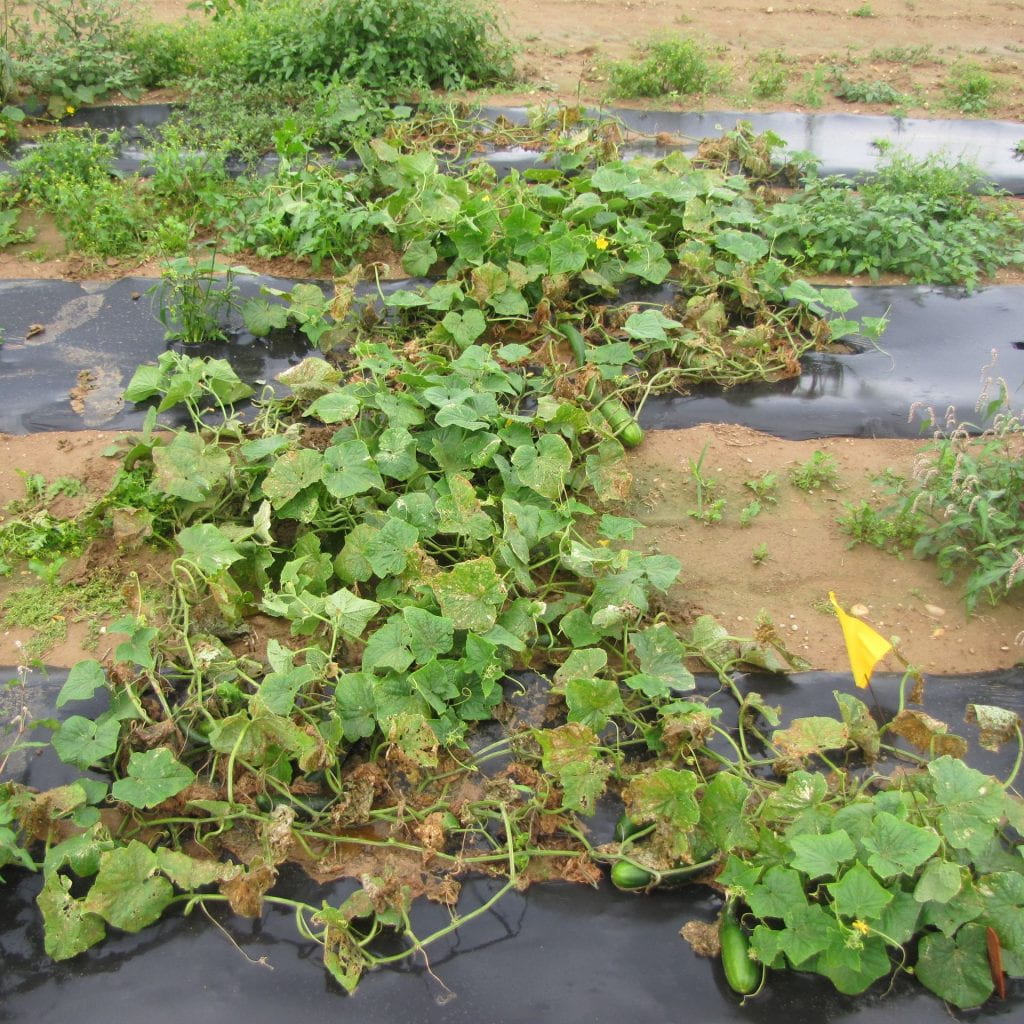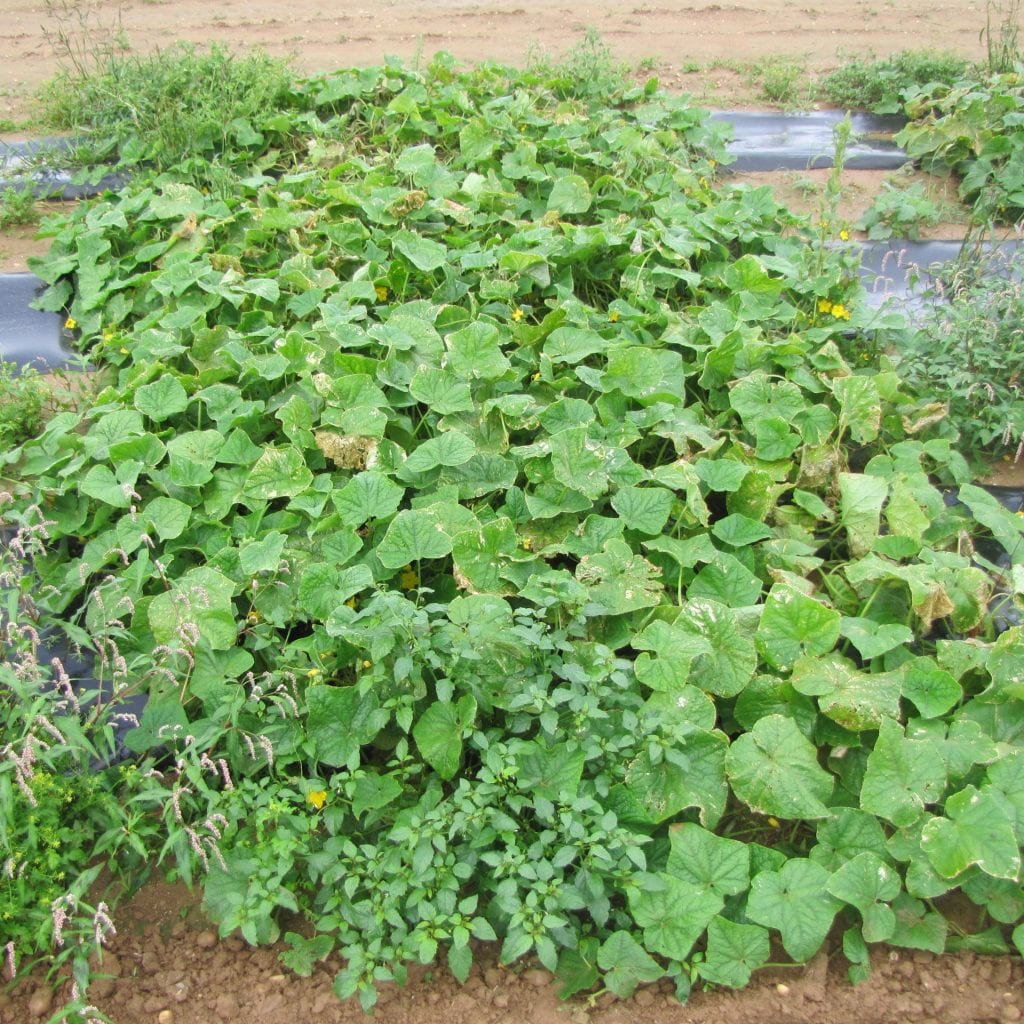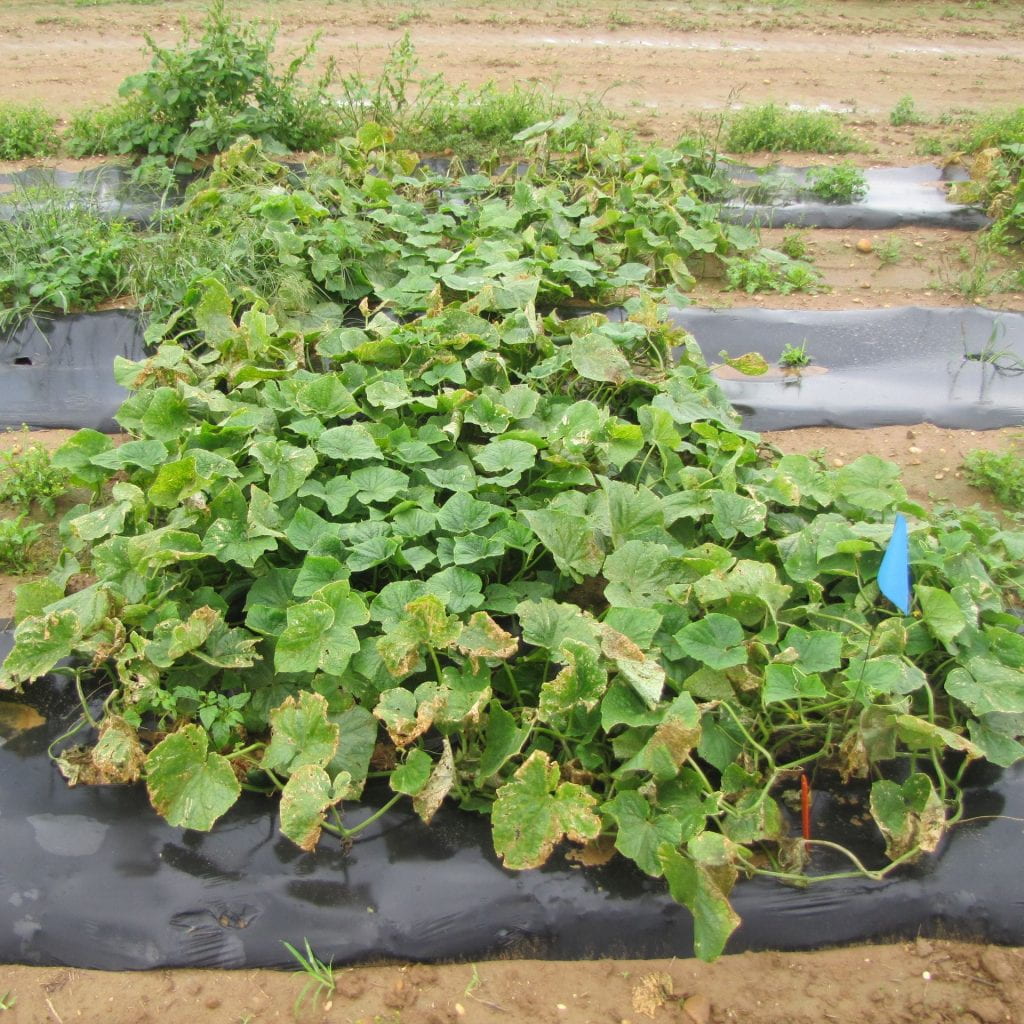This replicated experiment was conducted at LIHREC in 2021.
Topics on this page:
Downy mildew has been a major problem in cucurbit crops throughout the eastern U.S., including on Long Island, since 2004 when a new pathogen strain appeared in the U.S. The disease affects cucumbers every year and other cucurbit crops more sporadically because the pathogen exhibits host specialization and is dispersed here every summer via wind-blown spores. Leaves can quickly become severely affected in the absence of management when conditions are favorable. Loss can be quite extensive in cucumber as fruit production declines substantially in severely affected plants, much of the fruit produced is misshapen, and plants die prematurely. Resistant varieties are an important disease management tool, especially for a lower-value crop like cucumber, and for a disease like downy mildew that is variable in when it occurs and that is most effectively managed on a susceptible variety when fungicide applications are started before or when symptoms start to develop. First observation of downy mildew in cucumber on Long Island has varied from 14 July to 7 September. Applying fungicides when risk is predicted at the cucurbit downy mildew forecast website for where a crop is being grown helps avoid some unnecessary applications, but there can be several high-risk forecasts before infection occurs. A cucumber variety evaluation was conducted at LIHREC in 2021 to compare the new variety Brickyard and TSX-CU231AS, an experimental variety from Tokita, to Bristol and DMR401, both of which exhibited good suppression of downy mildew in previous variety evaluations, as well as to the susceptible variety Speedway. The goal was to obtain information about how these varieties perform in terms of disease resistance as well as fruit quality and yield in order to provide growers information they need to decide if any of the resistant varieties are suitable for their operation.
Procedures:
Mustard was grown in spring for biofumigation to manage the Phytophthora blight pathogen in the soil before planting the experiment. The field was moldboard plowed on 6 Apr and urea fertilizer (46-0-0) was applied at 80 lb/A N on 7 Apr. Mustard cover crop (Rojo Caliente) was seeded at 10 lb/A by drilling on 9 Apr. On 14 Jun the mustard was flail-chopped, immediately incorporated by disking, and followed by a cultipacker to seal the soil surface; the field could not be irrigated to initiate biofumigation as is recommended, but the soil was moist. Controlled-release fertilizer (N-P-K, 19-10-9) at 525 lb/A (101 lb/A N) was broadcast over the bed area and incorporated on 13 July. Beds were formed with drip tape and covered with black plastic mulch also on 13 July. Seeds were sown on 28 Jun in the greenhouse. A waterwheel transplanter was used to make planting holes in the beds and apply starter fertilizer (9-18-9). Seedlings were placed outdoors to harden for a few days before transplanting on 19 July by hand into the holes in the beds. A late planting date was used because some years downy mildew has not been seen on Long Island until September. During the season, water was provided as needed via drip irrigation lines. Weeds were managed between the mulched beds by applying herbicides and by hand weeding.
Plots were three 8-ft rows spaced 68 in. apart with 9 plants per plot at 2-ft spacing. The plots were 4 ft apart within the row initially until plants began to vine, partly filling the area. Vines were moved as needed to maintain plot separation. A randomized complete block design with four replications was used. No fungicides were applied. The primary source of initial inoculum of downy mildew in this area is long-distance wind-dispersed spores from affected plants. Downy mildew occurrence was assessed on 30 July; and 4, 12, 20, 26 and 31 August by estimating incidence of symptomatic leaves in each plot and rating severity on nine representative affected leaves. Canopy severity was calculated by multiplying incidence by average severity. Area under disease progress curve (AUDPC) values were calculated from 30 July through 31 August. AUDPC is a summation measure of severity over time. Defoliation, which was mainly due to downy mildew, was assessed on 31 August and 8, 14, and 22 September. Fruit were harvested, sorted by marketability, counted and marketable-sized fruit weighed on 13, 16, 24 and 31 August; and 10, 13 and 21 September. Only mis-shaped fruit were counted as unmarketable because harvest was not done often enough to avoid some fruit being over-sized. Fruit quality was evaluated independently by LIHREC staff and gardeners.
Results:
Downy mildew symptoms were first observed in one plot of the susceptible variety Speedway on 30 Jul, just 11 days after transplanting. All plots were found to be affected 4 days later at the next assessment. Downy mildew severity and incidence of affected leaves for the resistant varieties at all ratings were numerically lower, and usually significantly lower, than for Speedway (Table 1). TSX-CU231AS and DMR401 exhibited the best suppression of downy mildew throughout the season and least defoliation on 8 Sep. For some severity and incidence ratings they were significantly better than both Bristol and Brickyard. Brickyard was better than Bristol based on AUDPC values and 20 Aug ratings (data not shown). Control of downy mildew achieved based on AUDPC values for canopy severity was 57% for Bristol, 76% for Brickyard, 87% for TSX-CU231AS, and 94% for DMR401. TSX-CU231AS and DMR401 produced more fruit than the other resistant varieties; all four produced more fruit than Speedway (Table 2). On the first harvest date all plots had fruit ready to harvest with none over-sized. Fruit of TSX-CU231AS received the highest average for all ratings for fruit quality (Table 3). DMR401 produced a more vigorous canopy that the others thus foliage more thoroughly covered the plot area (see Figure 1 below of representative plots).
Discussion and Conclusions:
All resistant varieties exhibited good to excellent control of downy mildew, especially considering how soon after transplanting the disease started to develop. The three newest varieties were better than Bristol, which performed well in the last cucumber variety evaluation conducted at LIHREC which was in 2017. TSX-CU231AS and DMR401 yielded the most. All exhibited similar onset of fruit production and had harvestable fruit at first harvest.
Results from downy-mildew resistant variety evaluations conducted at the University of Massachusetts from 2017-2021 confirmed some of these results and yielded additional valuable information. Brickyard was among the most resistant varieties and experimentals tested in 2021. TSX-CU231AS and two other Tokita experimentals (TSX-CU234AS and TSX-CU236AS) exhibited the best resistance when tested (2020). They were better than Raceway which was among the best in 2021. TSX-CU231AS was also best in 2019 when it was better than Bristol. DMR401 exhibited best resistance in 2018, but, in contrast with the LIHREC results, it was not as effective as Bristol when it was also evaluated (2017). Citadel, a fresh-market pickle type, exhibited good resistance when evaluated in 2018; it was the only variety tested that was not significantly more severely affected than DMR401. It also exhibited good resistance when evaluated at LIHREC in 2017. All of these yielded well.
TSX-CU231AS, TRI-CU234AS, TRI-CU236AS, Brickyard, DMR401, and Citadel are all recommended based on these evaluation results. Bristol and Raceway are also good choices.
Additional information: At the Cornell Vegetables website there are lists and tables of resistant vegetable varieties that include seed companies marketing them and whether organic seed is available, as well as variety resistance to disorders, and also additional information about downy mildew and its management.
Margaret Tuttle McGrath
Plant Pathology and Plant-Microbe Biology Section, SIPS, Cornell University
Long Island Horticultural Research and Extension Center
3059 Sound Avenue, Riverhead, NY 11901
mtm3@cornell.edu
Acknowledgments: This project was supported by the National Institute of Food and Agriculture, U.S. Department of Agriculture, Hatch under NYC-153409 and the Friends of Long Island Horticulture Grant Program.
Tables
Table 1. Ability to suppress downy mildew of resistant varieties of cucumber. Data for the last two entries are from single observational plots.
| Variety | Downy mildew occurrence z | ||||||||||||||
| Incidence of symptomatic leaves (%) | Canopy severity (%) y | ||||||||||||||
| 4 Aug y | 26-Aug | AUDPC y | 4-Aug | 12-Aug | 26-Aug | AUDPC | |||||||||
| Speedway (susceptible) | 21.5 a | 83 a | 1611 a | 2.16 a | 18 a | 58 a | 867 a | ||||||||
| Bristol | 7.3 ab | 39 b | 1062 b | 0.26 ab | 13 ab | 13 b | 371 b | ||||||||
| Brickyard | 4.4 b | 39 b | 848 c | 0.08 b | 8 abc | 9 bc | 211 c | ||||||||
| TSX-CU231AS (experimental) | 3.9 b | 24 c | 457 d | 0.06 b | 6 bc | 7 c | 109 d | ||||||||
| DMR401 | 5.7 b | 9 d | 366 d | 0.09 b | 3 c | 2 d | 55 d | ||||||||
| P-value (variety) | 0.005 | <0.0001 | <0.0001 | 0.0093 | 0.0005 | <0.0001 | <0.0001 | ||||||||
| CU-201AS | 5 | 45 | 993 | 0.15 | 8.75 | 15.8 | 463 | ||||||||
| CU-203 | 4 | 45 | 1119 | 0.12 | 12 | 9 | 441 | ||||||||
z Numbers in each column with a letter in common are not significantly different from each other (Tukey’s HSD, P=0.05).
y Values were square root transformed before analysis because raw data were not distributed normally. Table contains de-transformed values.
Table 2. Impact of powdery mildew suppression on defoliation and yield in cucumber resistant varieties. Data for the last two entries are from single observational plots.
| Variety | Defoliation (%) z | Marketable fruit z | Fruit/plant z | |||||||||||
| 31 Aug y | 8-Sep | % | lb/plant x | oz/fruit | harvest 1 + 2 | all harvests | ||||||||
| Speedway (susceptible) | 17 a | 91 a | 67 ab | 2.3 c | 7.6 b | 2 ab | 7.4 c | |||||||
| Bristol | 4.3 b | 71 a | 70 ab | 4.9 b | 9.4 a | 2.6 a | 11.7 b | |||||||
| Brickyard | 3.4 b | 66 a | 76 a | 5.1 b | 9.3 a | 1.7 ab | 11.6 b | |||||||
| TSX-CU231AS (experimental) | 0.5 b | 40 b | 62 b | 6.8 a | 9.6 a | 1.4 ab | 18.4 a | |||||||
| DMR401 | 1.2 b | 31 b | 63 b | 7.1 a | 8.8 ab | 0.8 b | 20.4 a | |||||||
| P-value (variety) | 0.0001 | <0.0001 | 0.014 | <0.0001 | 0.017 | 0.0065 | <0.0001 | |||||||
| CU-201AS | 5 | 55 | 82 | 1.1 | 2.8 | 0.4 | 7.9 | |||||||
| CU-203 | 5 | 75 | 79 | 2.2 | 5.5 | 2.8 | 8.1 | |||||||
z Numbers in each column with a letter in common are not significantly different from each other (Tukey’s HSD, P=0.05).
y Values were square root transformed before analysis because raw data were not distributed normally. Table contains de-transformed values.
x Fruit that became over-sized because of extended time between harvests were not weighed. Yield per plant was estimated by multiplying average weight of marketable-sized fruit by number of fruit with marketable shape (straight and even).
Table 3. Average ratings for fruit of susceptible and downy mildew resistant varieties of cucumber evaluated on a 1 (poor) to 5 (excellent) scale for several parameters by 18 people. Varieties are listed based on overall average rating.
| Appearance | Would you buy? | |||||||
| Variety | Size | Shape | External | Internal | Taste | Texture | Average | |
| Speedway (susceptible) | 3.9 | 4.1 | 3.9 | 4.4 | 3.7 | 4.3 | 4.05 | 89% |
| Brickyard | 4.2 | 4.2 | 3.8 | 4.5 | 3.6 | 4.1 | 4.06 | 61% |
| Bristol | 4.3 | 4.1 | 4.1 | 4 | 3.8 | 4.3 | 4.11 | 83% |
| DMR401 | 4.4 | 4.5 | 4.1 | 4.2 | 3.7 | 4.1 | 4.17 | 78% |
| TSX-CU231AS | 4.3 | 4.4 | 4.4 | 4.3 | 3.9 | 4.1 | 4.24 | 71% |
Images

Figure 1. Photographs of plots of each variety taken on 19 August, 20 days after symptoms found on the susceptible variety and 15 days after symptoms first seen on the resistant varieties. The other three plots of each variety appeared similar to these.
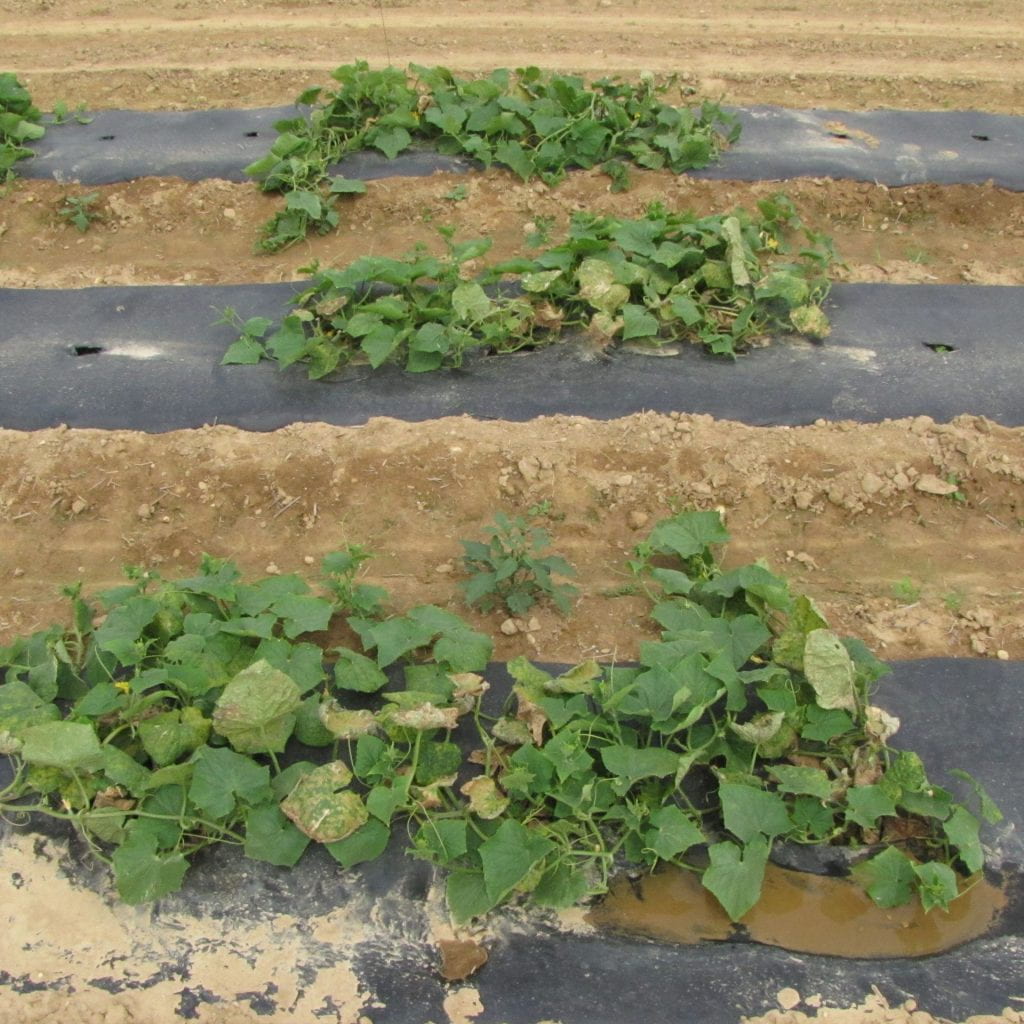

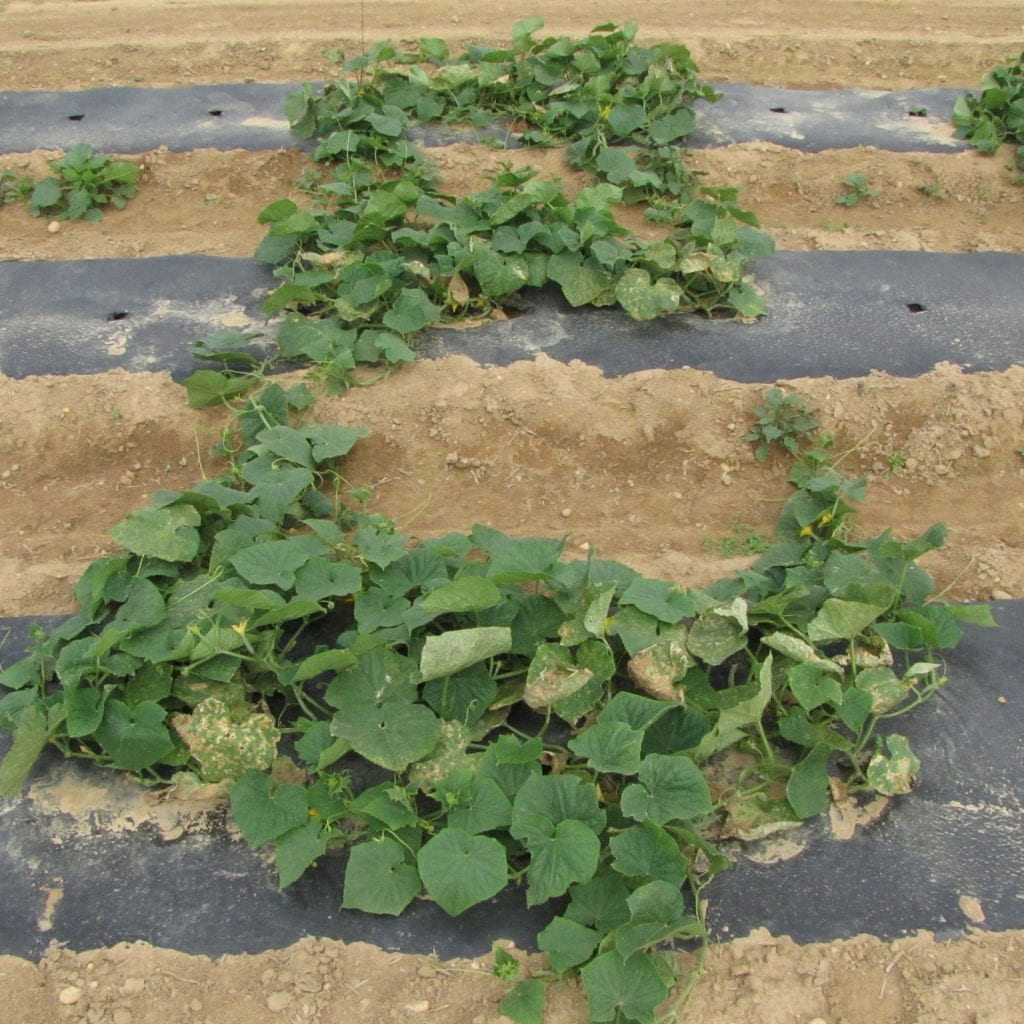
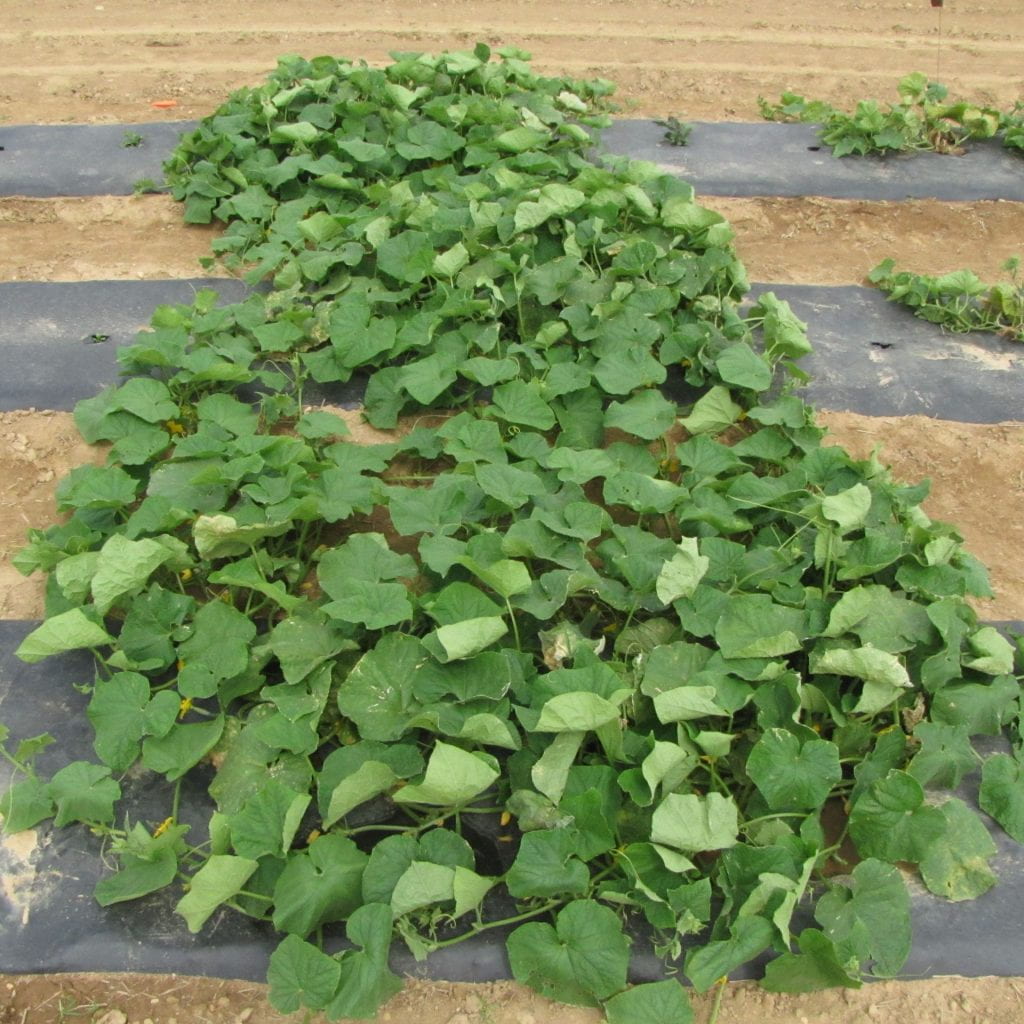
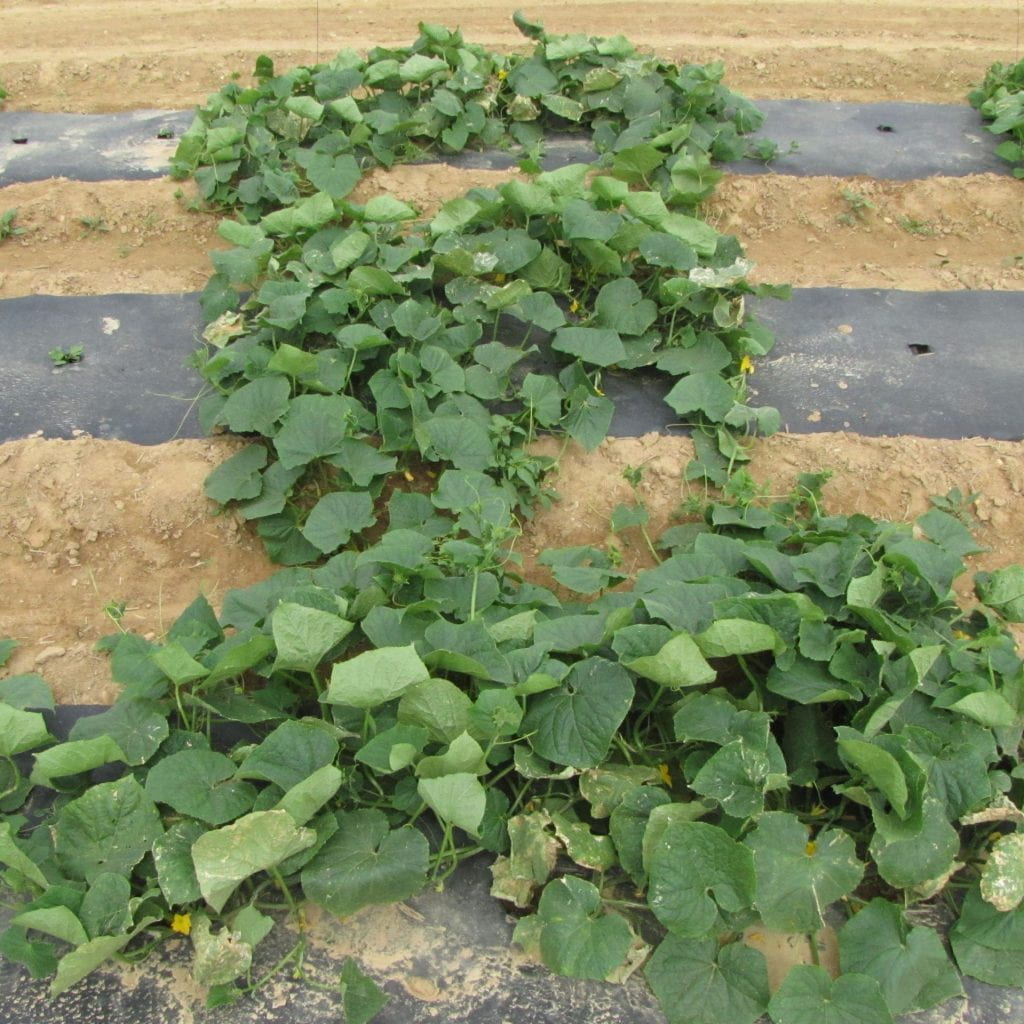
Figure 2. Fruit of Speedway (on left), Brickyard, Bristol, DMR401, and TSX-CU231AS (on right).
Figure 3. Photographs of fruit from each variety.

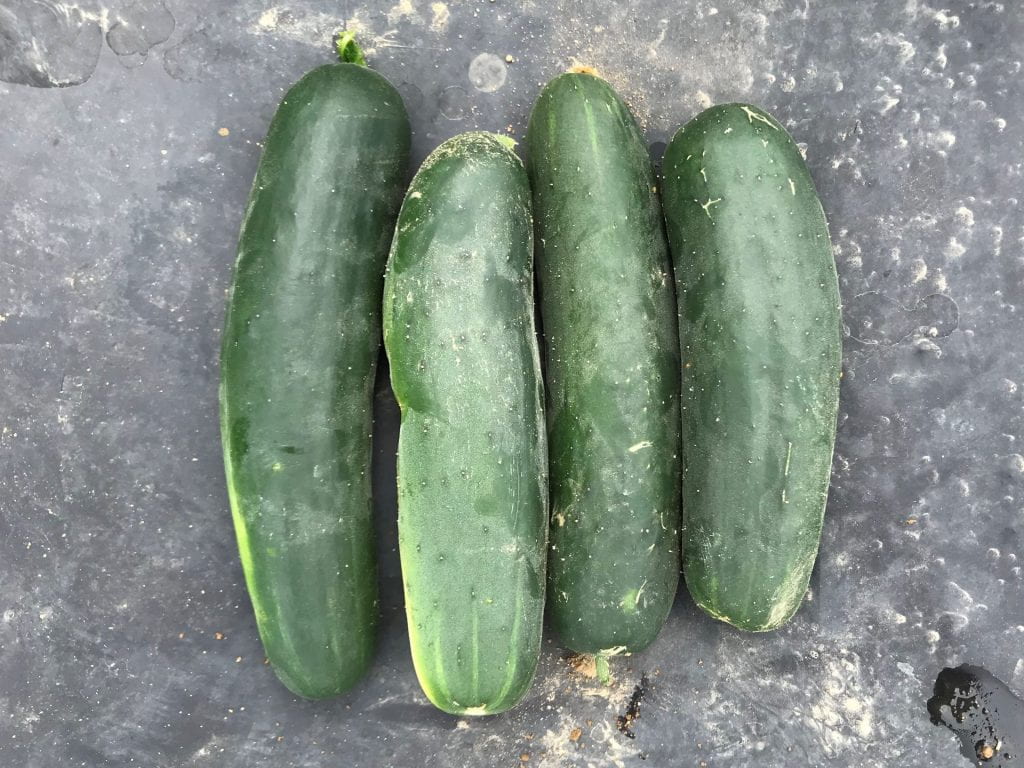
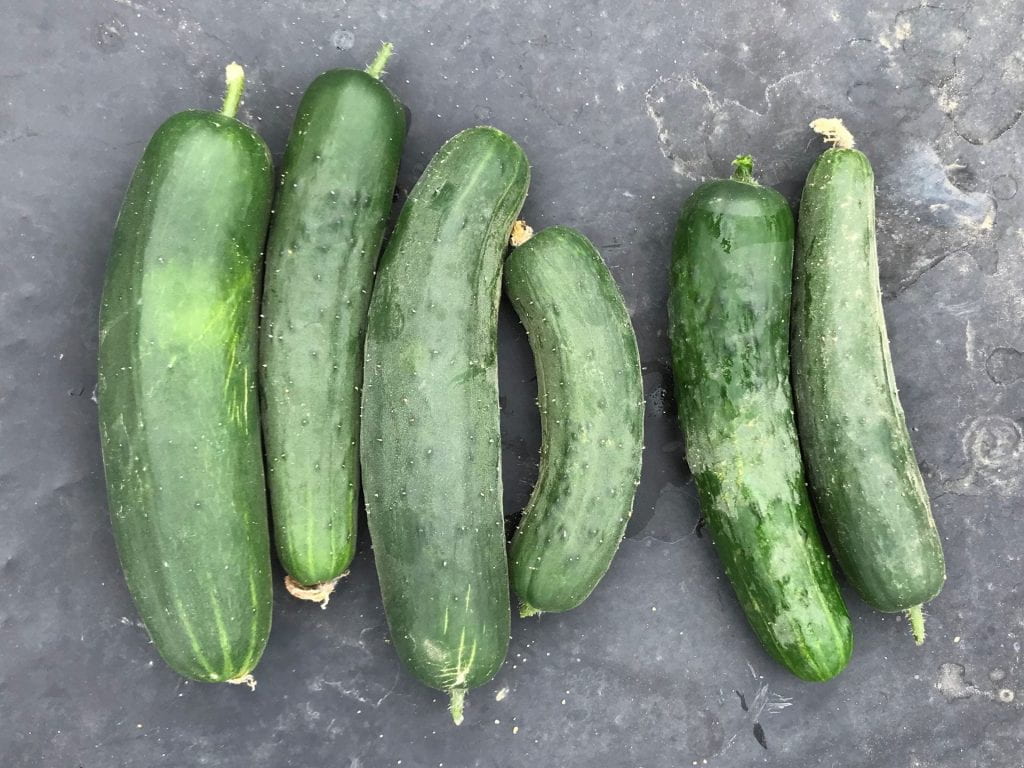
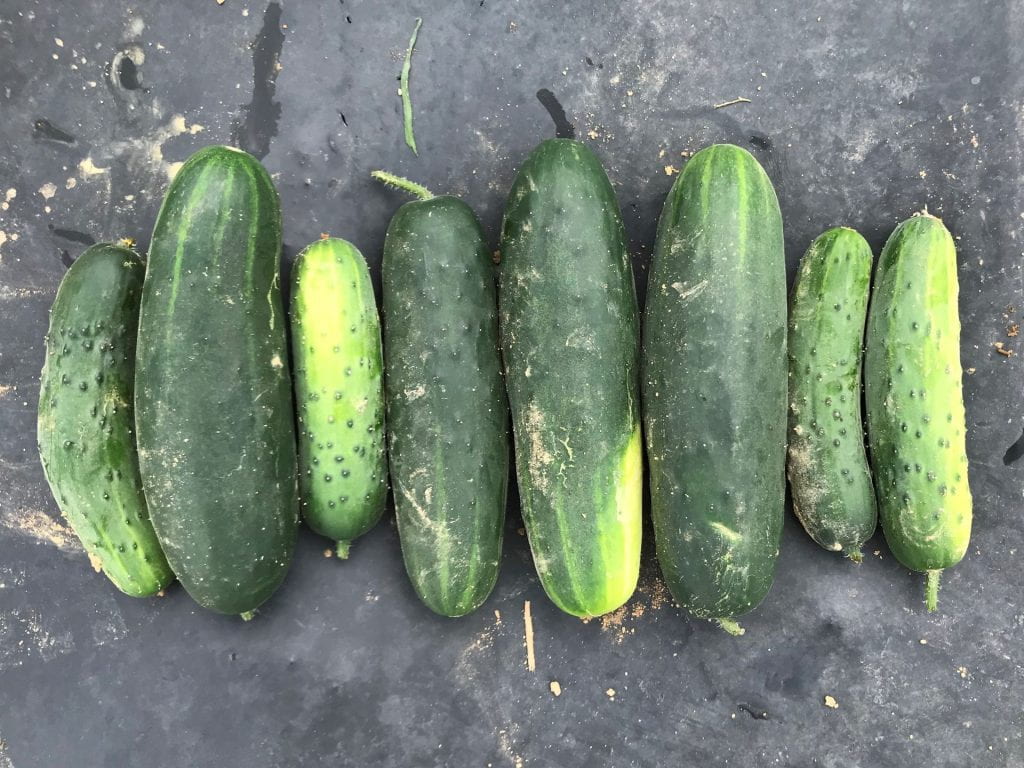
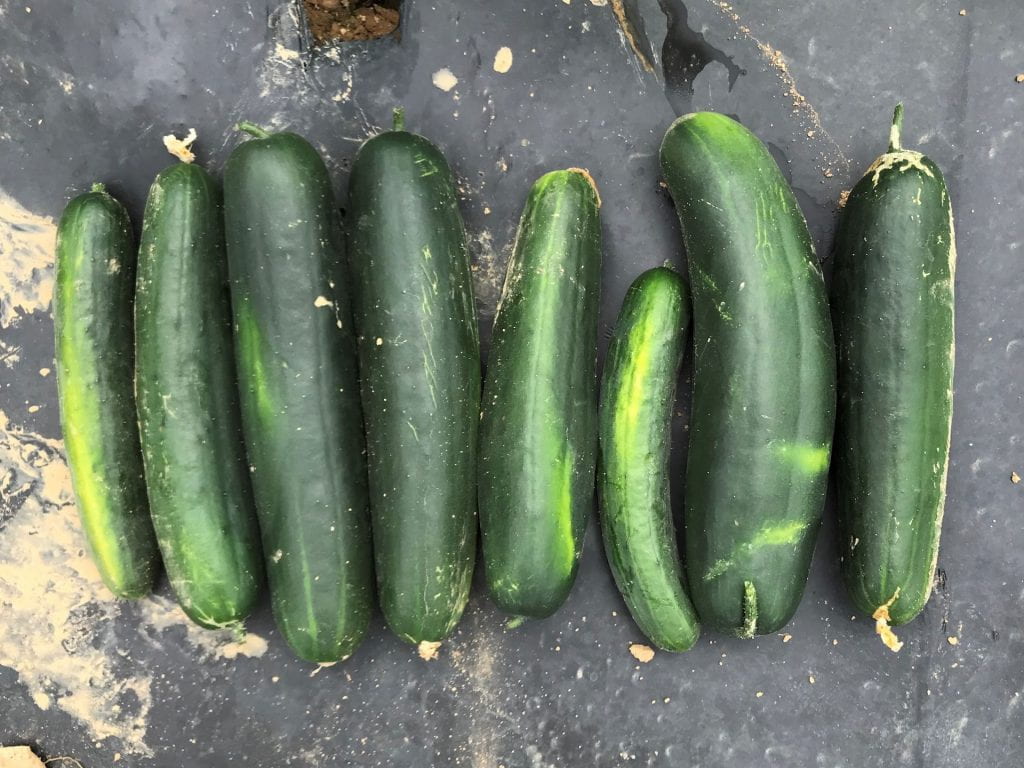
Figure 4. Photographs of plots of each variety taken on 9 September, 41 days after symptoms found on the susceptible variety and 36 days after symptoms first seen on the resistant varieties. The other three plots of each variety appeared similar to these.
